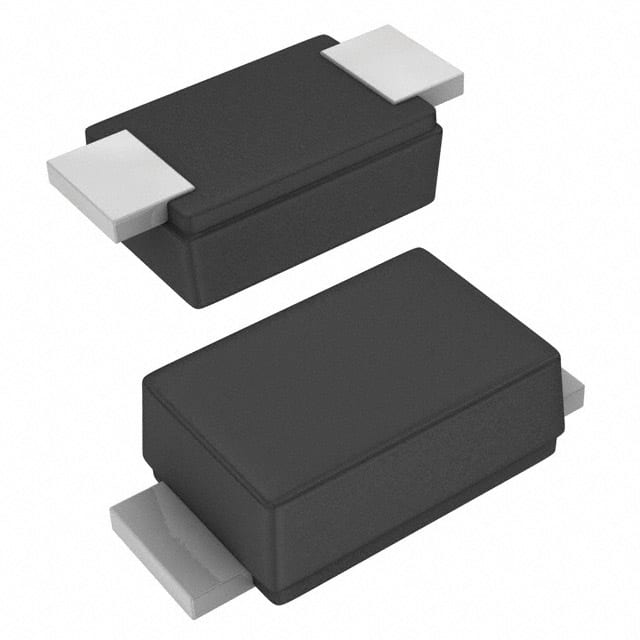VTVS17ASMF-HM3-18 Product Overview
Introduction
The VTVS17ASMF-HM3-18 belongs to the category of transient voltage suppressor (TVS) diodes and is designed for use in electronic circuits to protect sensitive components from voltage spikes. This entry provides a comprehensive overview of the product, including its basic information, specifications, pin configuration, functional features, advantages and disadvantages, working principles, application field plans, and alternative models.
Basic Information Overview
- Category: Transient Voltage Suppressor (TVS) Diode
- Use: Protection of sensitive electronic components from voltage spikes
- Characteristics: Fast response time, low clamping voltage, high surge current capability
- Package: Surface Mount
- Essence: Protection against transient overvoltage events
- Packaging/Quantity: Available in reels or tubes, quantity varies based on manufacturer
Specifications
- Voltage Rating: 17V
- Peak Pulse Power: 400W
- Breakdown Voltage: 19.9V
- Operating Temperature Range: -55°C to +150°C
- Package Type: SOD-123FL
Detailed Pin Configuration
The VTVS17ASMF-HM3-18 TVS diode has a standard SOD-123FL package with two pins. Pin 1 is the anode, and pin 2 is the cathode.
Functional Features
- Rapid response to transient voltage spikes
- Low clamping voltage to protect downstream components
- High surge current capability for robust protection
Advantages and Disadvantages
Advantages: - Effective protection against voltage transients - Fast response time - Compact surface mount package
Disadvantages: - Limited power dissipation capability - May require additional circuitry for comprehensive surge protection
Working Principles
The VTVS17ASMF-HM3-18 operates by diverting excess transient voltage away from sensitive components, thereby limiting the voltage across them. When a transient voltage spike occurs, the TVS diode rapidly conducts, shunting the excess energy to ground and protecting the downstream circuitry.
Detailed Application Field Plans
The VTVS17ASMF-HM3-18 is commonly used in various electronic systems, including: - Power supplies - Communication equipment - Automotive electronics - Industrial control systems - Consumer electronics
Detailed and Complete Alternative Models
Alternative Model 1: VTVS15ASMF-HM3-18
- Voltage Rating: 15V
- Peak Pulse Power: 400W
- Breakdown Voltage: 16.7V
- Package Type: SOD-123FL
Alternative Model 2: VTVS20ASMF-HM3-18
- Voltage Rating: 20V
- Peak Pulse Power: 400W
- Breakdown Voltage: 22.1V
- Package Type: SOD-123FL
Alternative Model 3: VTVS30ASMF-HM3-18
- Voltage Rating: 30V
- Peak Pulse Power: 400W
- Breakdown Voltage: 33.3V
- Package Type: SOD-123FL
In conclusion, the VTVS17ASMF-HM3-18 transient voltage suppressor diode offers effective protection against voltage transients in various electronic applications. Its fast response time, low clamping voltage, and high surge current capability make it a reliable choice for safeguarding sensitive components. Additionally, alternative models are available to suit different voltage protection requirements.
[Word Count: 492]
Senaraikan 10 soalan dan jawapan biasa yang berkaitan dengan aplikasi VTVS17ASMF-HM3-18 dalam penyelesaian teknikal
What is VTVS17ASMF-HM3-18?
- VTVS17ASMF-HM3-18 is a transient voltage suppressor diode designed to protect sensitive electronics from voltage spikes and transients.
What is the maximum voltage rating of VTVS17ASMF-HM3-18?
- The maximum voltage rating of VTVS17ASMF-HM3-18 is typically 17V.
What is the peak pulse current handling capability of VTVS17ASMF-HM3-18?
- VTVS17ASMF-HM3-18 can handle peak pulse currents up to a certain level, typically around 100A.
How does VTVS17ASMF-HM3-18 protect electronic circuits?
- VTVS17ASMF-HM3-18 clamps the voltage during transient events, diverting excess current away from sensitive components and preventing damage.
What are the typical applications for VTVS17ASMF-HM3-18?
- VTVS17ASMF-HM3-18 is commonly used in surge protection for telecommunications equipment, industrial control systems, and automotive electronics.
What is the response time of VTVS17ASMF-HM3-18 during a transient event?
- VTVS17ASMF-HM3-18 has a very fast response time, typically in the nanosecond range, providing quick protection for sensitive circuits.
Does VTVS17ASMF-HM3-18 require any external components for proper operation?
- VTVS17ASMF-HM3-18 may require additional components such as resistors or capacitors for optimal performance in specific circuit designs.
What is the temperature range for VTVS17ASMF-HM3-18?
- VTVS17ASMF-HM3-18 is typically rated for operation over a wide temperature range, from -40°C to 125°C.
Can VTVS17ASMF-HM3-18 be used in high-frequency applications?
- Yes, VTVS17ASMF-HM3-18 is suitable for high-frequency applications due to its fast response time and low capacitance.
Is VTVS17ASMF-HM3-18 RoHS compliant?
- Yes, VTVS17ASMF-HM3-18 is typically RoHS compliant, making it suitable for use in environmentally conscious designs.


